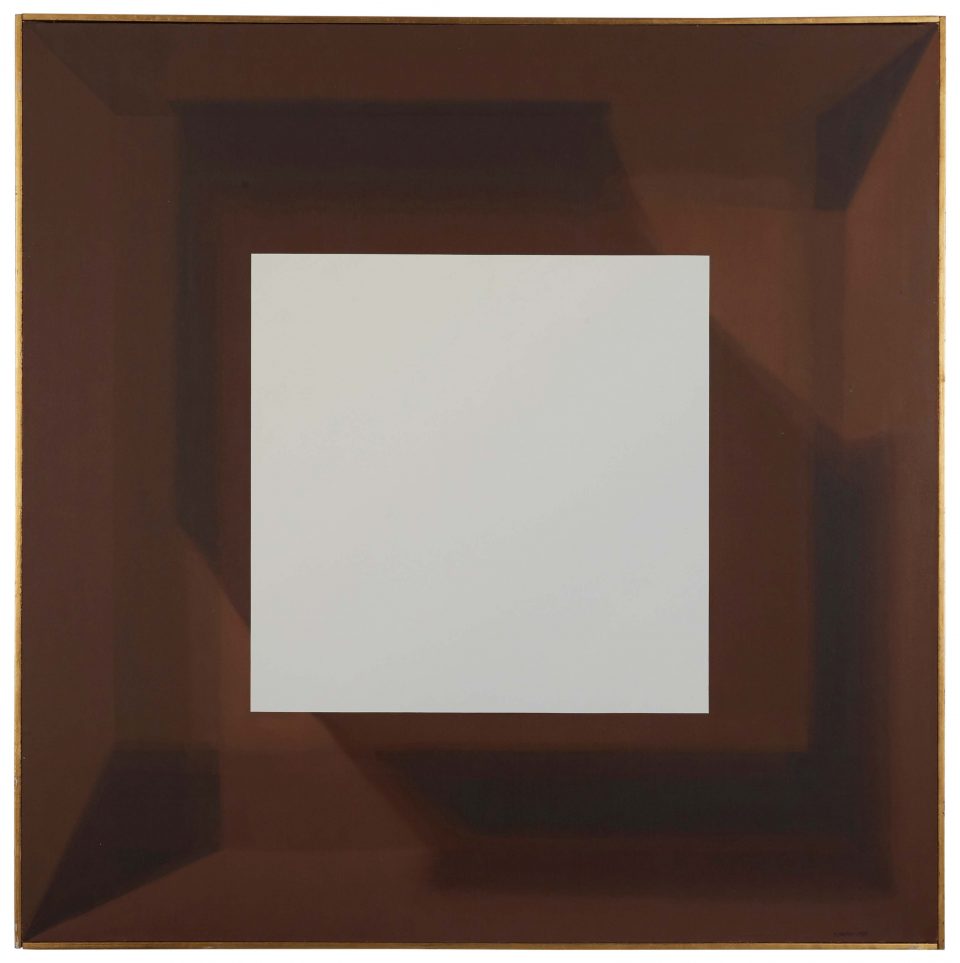
With a history of cultural iconoclasm, the Arab region has become a fertile ground for abstract art. Yet Arab artists remain marginal in the global conversation of modern abstraction. An ambitious project initiated by the Barjeel Art Foundation seeks to issue a long overdue corrective. Taking Shape: Abstraction from the Arab World, 1950s–1980s, slated to tour a number of museums in North America, had its debut at NYU’s Grey Gallery last January. The exhibition explores mid-20th-century abstraction from North Africa, West Asia, and the Arab diaspora and includes 90 works by artists who not only sought to recontextualize modernism but also represent a wide range of non-figurative art from indigenous practices.
Samia Halaby’s square painting, White Cube in Brown Cube (1969) is a case-in-point; a work, which seems to be an improvisation on the compositions of Josef Albers. Like the master modernist, Halaby was a migrant to the United States (by way of Palestine and Lebanon) who became the first full-time female faculty member of the Yale School of Art. But her work does more than offer a parallel vision. It also presents a paradox in a movement that sought to achieve an international language for art only to end up becoming an artistic expression that is peculiar to a specific culture. The empty square in the middle and the layered brownness that surrounds it, have been argued, are part of a visual vernacular inspired by the landscape of Palestine. The curator Suheyla Takesh furthers the same notion that “It may be the Arab world’s particular take on the art of landscape that it must be abstracted because it has been lost for generations.”
The lineage of Islamic painting in calligraphy looms large in Halaby’s work. Its geometric form can be interpreted as a simplified frontispiece of the Quran or 13th century books by Sufi poets. Saloua Raouda Choucair from Lebanon creates in the same vein. Her sculpture is rooted both in Islamic spirituality and imaginary architecture. Shakir Hassan Al Said of the Baghdad group (1951) combines aspects of Mesopotamian archaeological objects and cuneiform.
Beyond reprisal of traditional forms, the works tell stories of political conflicts: the rise and fall of Arab nationalisms, wars and mass migrations, and the oil boom that transformed the region. It is the awareness of political conflict that compelled these artists to synthesize traditional practices and confront their emerging Arabic identity. This is manifested in syncretic approaches of the hurufiyya, a type of abstraction through Arabic writing scripts practiced succinctly by Egyptian Omar El-Nagdi and Sudanese Ibrahim El-Salahi. The Palestinian Kamal Boullata takes it further by using phrases from both Islamic and Christian texts. Hurufiyya’s ubiquity in art fairs from Basel to Hongkong, is symptomatic of an increased awareness of the Arab World as a market for contemporary art but not necessarily in the same wave of revival in global modernism which Latin Americans are having at MoMA. This exhibition in a university museum evaluates Arabic abstraction beyond being a market trend and serves as a prequel and timely academic study of this cross-cultural development.
Taking Shape: Abstraction from the Arab World, 1950s–1980s at the Grey Gallery runs from Tuesday, January 14, 2020 to Saturday, April 04, 2020
Leave a comment